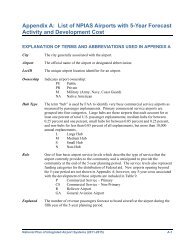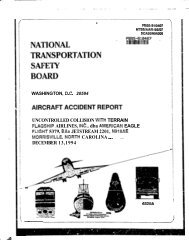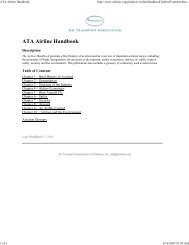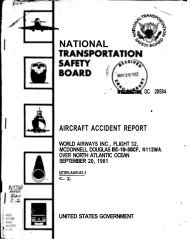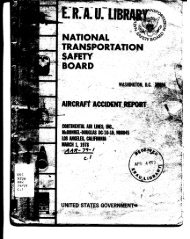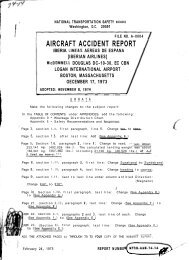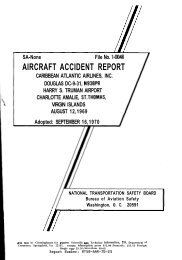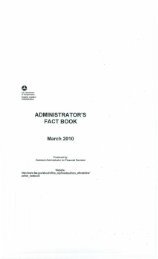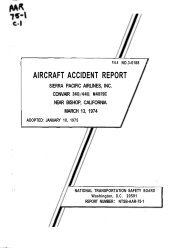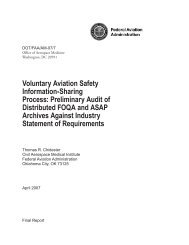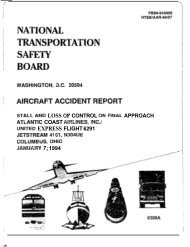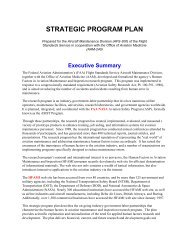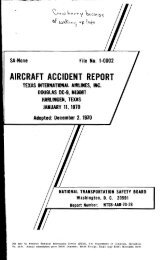NTSB/AAR-84-05 - AirDisaster.Com
NTSB/AAR-84-05 - AirDisaster.Com
NTSB/AAR-84-05 - AirDisaster.Com
You also want an ePaper? Increase the reach of your titles
YUMPU automatically turns print PDFs into web optimized ePapers that Google loves.
LAS WEGAS AIRLINES FLIGHT 88<br />
PIPER PA-31-350<br />
GRAND CANYON, ARIZONA<br />
AUGUST 17, 1983<br />
P<br />
UNITED STATES GOVERNMENT
D<br />
TECHNICAL REPORT DOCUNENTATION PAGE<br />
i . Repox No.<br />
1 2.Government Accession No. 3.Recipient's Catalog No.<br />
NTSS/<strong>AAR</strong>-<strong>84</strong>/<strong>05</strong><br />
i PB<strong>84</strong>-9104<strong>05</strong><br />
I. TiZle and Subtitle<br />
aircraft Accident Report-<br />
5.Peport Date<br />
.May 15, 19<strong>84</strong><br />
6.Performing Organization<br />
LSS Vegas Airlines, Flight 88, Piper PA-31-350,<br />
Grand Canyon, Arizona, August 17, 1983<br />
I Lour<br />
7. Autkor(s) 8.Performing Organization<br />
Report No.<br />
- -<br />
National Transportation Safetv Board<br />
Bureau of Accident Investigation<br />
Washington, D.C. 2<strong>05</strong>34<br />
1. Performing Orqanization Name and C.ddress ! 10.Work Unit No.<br />
I2.Sponsoring Agency Name<br />
NATIONAL TXANSPORTATION SAFETY BOARD<br />
Washington, D. C. 2<strong>05</strong>94<br />
15.Supplementary Notes<br />
I<br />
r.<br />
3795B<br />
11.Contract or Grant No.<br />
1 13.Type of Report and<br />
Period CoverEd<br />
Aircraft Awident Report<br />
August 17, 1983<br />
I5.Absiracc On August 17, 1983, Las Vegas Airlines Flight 88, a Piper PA-31-350, N88LV,<br />
was being operated as a scheduled Grand Canyon sightseeing flight from Las Vegas, Nevada, to<br />
Tusayan, Arizona. About 1142 p.s.t., Las Vegss 88 departed North Las Vegas Airport as the<br />
secend of five Las Vegas Airlines airplanes flying to Grand Canyon National Park Airport. The<br />
first portion of the flight over the Las Vegas Strip and Lake Mead was uneventful; however,<br />
weather conditions precluded the pilot of Las Vegas 88 from flying over the Shivwits Plateau<br />
under visual conditions as nnrmally done, so he flew into the west end of the Grand Canyon at<br />
5,OOC feet. Radio conversations between the pilot and other company pilots indicated that Las<br />
Vega5 88 encountered deteriorating weather conc'itions in the Canyon and that the p: dot had<br />
decided to abort the flight and climb out. Later attempts to contact Las Vegas 88 were<br />
fruitless. The wreckage was found on August 18, 1983, by company pilots on the west wall of a<br />
mesa inside the Canyon. The airplane was destroyed by impact and by posrimpact fire. The<br />
pilot and all nine passengers were killed.<br />
The National Transportation Safety Board determines that the prGbsble cause of<br />
this accident was &e pilot's failure to maintain adequate visual flight references to positively<br />
identify his position while flying below the rim of the Grand Canyon which resulted in his<br />
selection of an inappropriate fiightpath snd consequent collision with the terrain during an<br />
attempt to climb the airplane in instrument meteorological conditions to a ssfe altitude above<br />
the rim of the canyon.<br />
17.Key Words<br />
Grand Canyon, sightseeing flight, visual meteorological<br />
conditions, instrdment meteorological conditions,<br />
misidentification, Twin Peaks, deteriorating weather.<br />
TTB'TOMGicn Statement<br />
1 This document is aveilable<br />
' to the public through the<br />
i National Technical Information<br />
Sewice<br />
-<br />
Ig.5ecurity C!ti.siflcation<br />
(of this report)<br />
UNCLASSIFIED<br />
(of this page:<br />
l<br />
Springfield, Virginis 22161<br />
IZI.No. of Pages '22.Prlce<br />
I 1<br />
23<br />
.i1 I<br />
GTsB Form 1765.2 :2ev. 9/74:<br />
-.
1 .<br />
1.1<br />
1.2<br />
1.3<br />
1.4<br />
1.5<br />
1.6<br />
1.7<br />
1.8<br />
1.9<br />
1.10<br />
1.11<br />
1.12<br />
1.13<br />
1.14<br />
1.15<br />
1.16<br />
1.17<br />
1.17.1<br />
1.17.2<br />
1.17.3<br />
i.17.4<br />
2 .<br />
2.1<br />
2.2<br />
2.3<br />
2.4<br />
3 .<br />
3.1<br />
3.2<br />
4 .<br />
5 .<br />
5.1<br />
5.2<br />
5.3<br />
CONTENTS<br />
SrnOPS Is .......................... 1<br />
FACTLJAL iNFORMATION . .................. 1<br />
History of the Flignt ..................... 1<br />
Injuries to Persons ...................... 5<br />
Damage to Aircraft ...................... 5<br />
Other Damage ........................ 5<br />
Personnel Information . .................... 5<br />
Aircraft Information ..................... 5<br />
Veteorological Information . .................. 6<br />
Aids to .Navigation ...................... 8<br />
<strong>Com</strong>munications ....................... 8<br />
Aerodrome information .................... 8<br />
Flight Recorders ....................... 8<br />
Wreckage and impact Information . ............... 8<br />
Mcdical and Pathological Information .............. 10<br />
Fire ............................ 10<br />
Survival Aspects ....................... 10<br />
Tests and Research ...................... 10<br />
Additional Information . .................... 10<br />
Operational Authorization and Procedures ............ 10<br />
Scope of aperation ...................... 11<br />
FAA Surveillance . ...................... 12<br />
Accident History ....................... 13<br />
ANALYSIS . ......................... 13<br />
The Airplane . ........................ 13<br />
The Pilot .......................... 14<br />
Theirieather ......................... 14<br />
Operation in Limited Weather Conditions . ............ !5<br />
CONCLUSIONS . ....................... 16<br />
Findings ........................... 16<br />
Probaule Cause 17<br />
........................<br />
RECOMMENDATICGS . .................... 17<br />
APPENDIXES ........................ 19<br />
Appendix A-Investigation and Hearing . ............. 19<br />
Appendix 8-P ersonnel hiormation ............... 20<br />
Appendix C-Aircraft Information . ............... 21<br />
ii
D<br />
Adopted: May 15,9<strong>84</strong><br />
.<br />
NATIONAL TRANSPORTATIOH SAFETY BOARD<br />
WASHINGTON, D.C. 2<strong>05</strong>94<br />
AVIATIOX ACCIDENT REPORT<br />
LAS YEGAS AIRLINES,<br />
N88LV, PIPER PA-31-35G,<br />
GRAND CANYON, ARIZONA<br />
AUGUST 17, 1983<br />
sYNopsIs<br />
On August 17, 1983. Las Vegas Airlines Flight 88, a Piper PA-31-350, NESLV,<br />
was beiyg operated as a scheduled Grand Canyon sightseeing flight from Las Vegas,<br />
Necaoa, to Tusayan, Arizona. About 1142 p.s.t., Las Vegas 88 departed North Las Vegas<br />
Airport as the second of five La2 Vegas Airlines airplaanes flying to GragG Canyan National<br />
Park Airport. The first portion of the flight over the Las Vegas Strip and Lake Wead was<br />
uneventful; however: weather conditmns precluded the pilot of Las Vegas 88 from flying<br />
over the Shivwits Plezeau under visua! conditions as normally done, so he flew into the<br />
west end of the Grand Canyon at 5,000 feet. Sadio conversatiom between the pilot and<br />
other company pilots in6irated that Las Vegas 88 encountered deteriorating weather<br />
conditions in the Canyon &rid that the pilot had decided to abort the flight and cliab out.<br />
Later attempts to contact Las Veg-as 88 were fruitless. The wreckage was found on the<br />
wect wall of a mesa inside the Canyon on August 18, 1983, by company pilots. The<br />
airplane was destroyed by impact and by postimpact fire. The pilot and all nine<br />
qassengers were killed.<br />
The National Transportatior. Safety Board determines that the probable cause<br />
of this accident was the pilot's failure to maintsin adequate visual flight references io<br />
positively izentifp his position while flying below the rim of the Gr-and Canyon which<br />
resulted in nis selection of an inappropriate flightpath and subsequent collision with the<br />
terrain during an attemp? to climb in instrument meteorological conditions to a safe<br />
altitude ahve the Tim of the Canyon.<br />
1.1 Histor> of the Flight<br />
1. FACWAL INFORMATION<br />
On August 17, 1983, Piper PA-31-350, N88LV (Las Vegas 88) was being<br />
operated by ias Vegas Airlines as one of five LaS VegaS Airlines airplanes to depart North<br />
Las Vegas Airport to conduct sightseeing tours of the Grand Canyon. The pilot of Las<br />
Vega 33, the first airplane, a single-ngine Piper PA-32 Lance, indicated that he<br />
depar:-d North Las Vegas -4irport on schedule at 1133 p.s.t. 1/ The pilot of Las Vegas 88<br />
called for taxi instrcctions at 1135 and for takeoff clear&e at 2141. The flight w a<br />
cleared for takeoff, and, at 1142, Las Vegas 88 departed runway 7 with the pilot and nine<br />
passengers, all Italian nationals, aboard.<br />
b -<br />
1/ All times are Pacific daylight saving time based on the 24-hour clock unless otherwise<br />
noted.<br />
-
-2-<br />
At 1143, the pilot of Las Vegas 88 contacted departure control, z/ and after<br />
clearing the TCA at 1148, he contacted the Las Vegas Flight Serviee Station (FSS) to<br />
activate a pre-filed vimal flight rules (VFR) ffight pltin as follows:<br />
Las Vegas 88<br />
1148:37 Vegas Eighty Eight to open a one way flight plan to the Grand<br />
Caiyon, Gu&af&n, ten souls on board, airborne at four three.<br />
FS5<br />
1148:47 Las Vegas Eighty Eight, flight plan activated and he advised, sir,<br />
there has been a convective SIGMET issued now for Arizona,<br />
basically from Needles to Prescott southbound to sixty miles<br />
southeast, correction, sixty miles east of Prescott, areas of<br />
embedded thunderstorms moving from the south at one five knots,<br />
maximum tops three eight thousand feet, cells will mwe<br />
northwesterly at one five kncts, Air Cortez just departed a few<br />
minutes ago and they were unable to maintain VFR conditions<br />
below clouds, they broke up at, correction, they broke out at one<br />
one thousand five hundred feet and that position where they broke<br />
out was six zero miles east of the Las Vegas area sir.<br />
Las Vegas 88<br />
1149:30 Thank you very much.<br />
Las Vegas 88 proceeded en route and the pilot made no further contact with<br />
any other ATC facility or supporting facility.<br />
The third flight, Las Vegas 19, a PA-31-350 airplane, departed at 1145,<br />
followed at intervals of about 20 to 25 minutes by Las Vegas 77 and Las Vegas 22, both<br />
also twin-engine PB-31 airplanes.<br />
Las Vegas Airlines flights are normally conducted under visual flight rules<br />
(VFR). The preferred tour itinerary was to fly south over the Las Vegas strip, then<br />
easterly over the Hoover Dam, over Lake Mead, over the Shivwits Plateau, wer the Grand<br />
Canyon rim, and along the Colorado River to the Grand Canyon Fational Park Airport,<br />
Tusayan, Arizona. From the east end of Lake Mead, the airplanes were to fly easterly at<br />
appropriate visual altitudes over the Shivwits Plateau and then descend into the Grand<br />
Canyon at a point about 65 miles west of the Grand Canyon Airport. (See figure 1.) The<br />
flight routes are not fixed since the pilots may have to deviate to maintain visual<br />
meteorological conditions (VMC). In this area: the width of the Canyon varies from about<br />
4 to 15 miles and the elevation of the rim varies from about 6,300 to 8,000 feet. 31 The<br />
return flights were to be made at higher altitudes (10,000 feet or above) direct from<br />
Grand Canyon Airport to North Las Vegas Airport.<br />
21 The Las Vegas terminal area is designated as a Group I1 Terminal Control Area<br />
DCA) and all flights departing North Las Vegas Airport are required to contact departure<br />
control and are assigned coded departure (and arrivai) routes, dependent on the runway in<br />
use at McCarran Airport which is 9 miles south of the North Las Vegas Airport. Pilots<br />
using these coded departure and arrival routes must operate in VFP, conditions at all times<br />
E& must inform approach control if weather conditions preclude the continuation of R<br />
flight. Radar service is automatically terminated when a departix aircraft leaves the<br />
TCA.<br />
-<br />
3/ All altitudes are mean sea level, unless otherwise noted.
A Lake Mead Vulcan's Throne<br />
..<br />
Sandy<br />
D-i..+<br />
Springs<br />
Colorado River<br />
1 -<br />
National Park<br />
Not to Scale<br />
Airport<br />
65 Miles ><br />
170 Miles _-<br />
Figure I.-Sightseeing route.
-4-<br />
Las Vegas Airlines pilots and all other commercial pilots communicate with<br />
each other while flying Grand Canyon sightseeing tours from Las Vegas to Grand Canyon<br />
Airport on discrete frequency 123.<strong>05</strong> MHz before entering the Canyon, and on discrete<br />
frequency 122.75 XHz for the remainder of the route. The pilots communicate with each<br />
other on 123.<strong>05</strong> MHz for the entire route from Grand Cariyon Airport. Consequently, all<br />
flights at appropriate visual altitudes are on one frequency and those flights in the Grand<br />
Canyon are on another. <strong>Com</strong>munications concern airplane position, weather conditions,<br />
tour information, and other operational information.<br />
The pilot of Las Vegas 33 stated that Las Vegas 88 passed 2 Piles to the right<br />
of and about 1,000 fecr above his airplane just east of Temple Bar, Arizona (the Piper<br />
PA-31 has a higher cruise speed). The pilots of Las Vegas 33, Las Vegas 88, and Las<br />
Vegas 19 communicated among each other en route on the appropriate discrete frequency<br />
concerning the weather and possible routing. Las Vegas 88 called over Sandy Point,<br />
Arizona, and stated that he was proceeding north to avoid a rain shower, which was<br />
located just swath of the west end of the Grand Canyon. Shortly thereafter, Las Vegas 88<br />
reported that he was entering the Canyon west of the Shivwits Plateau. This transmission<br />
was followed by a communications exchange between Las Vegas 33 and Las Vegas 88<br />
regarding whether or not they couId proceed across the south end of the Shivwits Plateau.<br />
Las Vegas 88 reported that the weather looked bad to the north (on the Shivwits) and that<br />
he was heading south to the Colorado River. Las Vegas 88 began calling radials off the<br />
Peach Springs VORTAC while flying at 5,000 feet. The pilot of Las Vegas 33 rezalled<br />
hearing the 340' radial. The pilot of Las Vegas 19 later estimated that the radials called<br />
by the pilot of Las Vezas 88 would have placed the airplane in the canyon between Peach<br />
Springs and Xount Dellenbaugh. Then, the other pilots heard the pilot of Las Vegas 88<br />
trensmii that he was jusC shcrt of Twin Peaks, but that he couid not see them yet. The<br />
last transmission from Las Vegas 88 that was overheard by other Las Vegas pilots was "Its<br />
getting too bad in here, I'm getting out." Las Vegas 33 attempted twice to contact Las<br />
Vegas 88 lo suggest that Las Vegas 88 proceed north of Mt. Dellenbaugh. Wowever, there<br />
was no response to either call.<br />
pilot of Las Vegas 88 reported that he was entering the Canyon, the<br />
' stated that he decided not to enter the Canyon in the single engine<br />
airplane and that he turned back to the west. He then climbed north.-iest over the<br />
Shivwits Plzteau, where the weather was better, and then east, proceeding north of<br />
.ill. Dellenbaugh et 9,500 feet. He then headed southeast and descended into the Canyon<br />
just west of Lava Dam Repids and continued the tour.<br />
The pilot of Las Vegas 19 indicated that he heard a radio conversation between<br />
the piiots of Las Vegas 33 and Las Vegas 83 in which they discussed the weather north on<br />
the Shivwits and that he decided to fly into the Canyon. He heard the pilot of Las Vegas<br />
88 call the Peach Springs radials and then state that he was in the area of Twin Peaks and<br />
climbing out. At this time, Las Vegas 19 was flying north in the Canyon south of Twin<br />
Peaks, ahead of Las Vegas 88, and the pilot stated that the cloud cover ahead precluded<br />
visual flight so he c1imb:ed in VVC between layers to 9,000 feet and flew east about<br />
10 miles Sefope reeniering the canyon east of Twin Peaks. He was then able to complete<br />
the Grand Canyon tour.<br />
Las Vegas 77 and Las Vegas 22 completed their sightseeing trips in VMC by<br />
flying over the Shivwits P,ateau north of Mt. Dellenbaugh.<br />
36%950" N. iatitude and 11397' 15" W. longitude at an altitude of 6,320 feet. The next<br />
Las Vegas 82 crashed abo?lt 1227 during daylight hours at coordinates<br />
day, ebout 1200, two co.mpany pilots flying a search mission in Las Vega 48 found the<br />
wreckage of Las 'v'egas 88 on the west side of a mesa inside the Grand Canyon.
Injuries to Persons<br />
-5-<br />
Injuries Crew Passengers Others Total<br />
Fatal 1 9 0 10<br />
Serious<br />
Minor/None<br />
0<br />
- 0<br />
0<br />
- 0<br />
9<br />
0<br />
- 0<br />
0<br />
-<br />
10<br />
0<br />
Total 1<br />
1.3 Damage to Airplane<br />
The airprane was destroyed oy impact forces aRd the postaccident ground fire.<br />
1.4 Other Damage<br />
None.<br />
1.5 Personnel Information<br />
The pilot was certificated and qualified for the flight. (See appendix B.j At<br />
the time of the accident, the pilot had been on duty for 2.25 hours and had flown for about<br />
45 minutes. Before reporting for duty on August 17, he had been off duty since 1700 the<br />
day before. He had flown 5.3 hours on August 16, 1983, and 1.8 hours on August 15, 1983.<br />
Other company pilots statld that he appeared well rested and e.cted norwal before the<br />
flight.<br />
B Pilots employed by Las Vegas Airlines, inc., are paid per flight based on a<br />
varying scale dependent upan the type of flight. Pilots report for duty at least 1 hour<br />
before scheduled departure time; they review the airplane recorls, obtain a passenger<br />
manifest, caL@hte weight and balance based upon passenger load, pick up the appropriate<br />
lenguage tape for the tour, obtair! weather information if rewired, then, escort and board<br />
the passengers on the airplane at the appropriate time. Pilots are required to enter the<br />
tine they report for duty on the completed weight ana balance form and to sign the<br />
following statement-. .<br />
I certify that I have had 10 hours of rest and will not exceed 8 hours of<br />
<strong>Com</strong>mercial flying during the 24 hours preceding the planned completion<br />
of this assignment.<br />
The pilot of Las Vegas 88 had signed the form.<br />
1.6 Aircraft Information<br />
The aircraft was certificated, equipped, and maintained in accordance with<br />
Federal Aviation Administration (FAA) requirements. (See appendix C.) The gross weight<br />
and center of gravity (c.g.) were within prescribed limits. At takeoff, 110 galions of fuel<br />
were onboard the airplane; on the basis of probable fuel consumption abmt 70 gallons<br />
remained at the time of the accident.<br />
A review of the maintenance records for Las Vegas 88 disclosed that the<br />
pilot's and copilot's altimeters were replaced on August 15, 1983. The work was<br />
accomplished in compliance . ,ith the 24-month altimeter inspection as required by 14<br />
CFR 91.170. Both a1timete.s were functionally tested and certified to 35,000 feet by<br />
Hughes Aviation Services, Las Vegas, Nevada, on August 8, 1983. During the inspection,
-6-<br />
the transponder encoder also was replaced. The encoder was functionally tested and<br />
certified to 25,000 feet by Hughes Aviation Services on July 25, i983. Both altimeters<br />
were pressure tested after installation; however, the encoder was not calibrated with the<br />
transponder before the accident. flight. Although this failure to calibrate would not affect<br />
the accuracy of the pilot's altimeter, Las Vegas Airlines operating procedures require that<br />
the encoder be calibrated before the airplane is used for instrument flight. Calibration Of<br />
the encoder is required for instrument operation in controlied airspace.<br />
1.7 Meteorological Information<br />
The hourly surface weathei observations for Grand Canyon National Park<br />
Airport (GCN), 64 miles east of the accident site, and for McCarran International Airport,<br />
Las Vegas, Nevada (LAS), 1<strong>05</strong> miles west of the accident site on the day of the accident<br />
were, in part:<br />
LAS<br />
Time--l150; type--record special; clouds--500 feet scattered, ceiling<br />
estimated 1,500 feet broken, 4,OOC feet overcast; visibility-4 miles;<br />
tower visibility--2 1/2 miles; weather--light rain showers and fog;<br />
temperat~re--73~ F; dewp0int--68~ F; wind--140° 4 knots;<br />
altimeter--30.03 inches; remarks -- cumulonimbus all quadrants moving<br />
north, surface visibility 4 miles, wind variable.<br />
Tirne--1204; type--special; clouds--500 feet scattered, ceiling<br />
$:<br />
estimated 1,500 feet broken, 4,000 feet overcast, visibility--? miles:<br />
weather--none; wind--120° 4 knots; altimeter--30.02 inches; remarkscumulonimbus<br />
all quadrants moving north, rain ended 12<strong>05</strong>.<br />
GCN Time--1145; type--surface aviation; clouds--1,000 feet scattered,<br />
'.'.. ceiling estimated<br />
visibility--ZO miles;<br />
2,000 feet broken,<br />
weather--none;<br />
10,000 feet overcast:<br />
temperat~re--68~ F:<br />
dewpoint--missing; wind--21i11 6 knots; altirneter--30.26 inches:<br />
remarks--occasional light rain showers. rain showers intensity unknown<br />
all quadrants, occasional lightning cloud to ground northwest.<br />
Time--1245; type--surface aviation; ceiling--estimated 2,000 feet<br />
broken, 10,000 fee? overcast: visibility-20 miles; weather-none:<br />
temperature-69'F.;<br />
dewpoint--missing; wind--calm:<br />
altimeter--30.25 inches; remarks--rain showers intensity unknown alt<br />
quadrants, occasional light rain showers, occasional lightning cloud to<br />
ground southeast.<br />
Time--1315; type-special; ceiling-weather 400 feet obscured;<br />
visibiiity- 1 mile, light rain and fog; wind-230° 5 knots; aitimeter--<br />
30.26 inches.<br />
The 1130 radar overlays from the National Weather Service Offices at the Palmdale<br />
and Salt Lake City Air Route Traffic Countrol Centers showed two large cloiid systems of<br />
light rain showers with isolated thunderstorms: one to the south of Las Vegas which<br />
extended east, and one immediately west of Las Vegas which extended north. Both<br />
systems were observed moving to the norrh at &bout 10 knots.<br />
northern edge of the system had moved over the accident site. The precipitation area<br />
The 1230 overlays showed that the two lmge cloud systems had joined and that the<br />
ccnsirted of light rain shower with a few moderate rain showers.
D<br />
-7-<br />
The following terminal forecasts for Las Vegas and the Grand Canyon were issued at<br />
0<strong>84</strong>0/17 by the National Weather Service Forecast Offices at Keno and Phoenix,<br />
respectively, and were valid from 0900/17 to 0900/18.<br />
Las Vegas.<br />
1100: Ceiling 8,000 feet broken. Occasionally ceiling 5,000 feet broken<br />
with light rain showers. Chances of ceiling 1,000 feet broken, visibility<br />
2 miles in thunderstorms wjth light rain showers with wind gusts to<br />
30 knots.<br />
Grand Canyon.<br />
1100: Clouds 5,000 feet scattered, ceiling 10,000 feet broken, scattered<br />
variable broken. Chance of ceiling 4,000 feet broken visibility 5 miles in<br />
thunderstorms with moderate rain showers or just moderate rain<br />
showers, wind gusts to 35 knots til 2200.<br />
The following convective SIGMETs were issued by the National Severe<br />
Storms Forecast Center, Kansas City, Missouri:<br />
July 17, 1<strong>05</strong>5<br />
Convective SIGMET 6W<br />
Arizona<br />
From Needles to 60 miles east of Prescott to 50 miles east-mrtheast of<br />
Tucson to Needles.<br />
Area of embedded thunderstorms moving from 170° at 15 knots. Tops to<br />
38,000 feet. Forecast to 1255: Area will move northward at 15 knots<br />
through 1255.<br />
July 17, 1155<br />
Convective SIGMET 7W<br />
Arizona<br />
From 20 miles eest of Prescott to 80 miles southwest of Saint Johns to<br />
60 miles north of Tucson to 20 miles southwest of Prescott to 20 miles<br />
east of Prescott.<br />
Area of embedded thunderstorms moving from 170 degrees to 15 knots.<br />
Tops to 38,000 feet. Forecast to 1355: Area sill move northward at<br />
15 knots through 1355.<br />
In 1982, the weather at Las Vegss McCarran Airport 41 was below VFR minimums<br />
(1000-foot ceiling and less than 3 miles visibility) for .03 percent of the surface<br />
observations, and below marginal VFR (?vlVFR) minimums 13,000-foot ceiling and 5 miles<br />
visibility) for .2 percent of the surface observations. The weather at Pulliam Airport,<br />
Flagstaff, Arizona, ?/ was below VFR minimums for 9.5 percent of the observatiocs and<br />
below MVFR minimums 17 percent of the observations. 'The percentages are<br />
representative of the existing weather in hours based upon the time that the airport tower<br />
is operational. There were no observations at either airport below VFR minimums in the<br />
months between April and September. The FAA manager of the Grand Canyon Control<br />
Tower 6/ stated that the airport is below VFR minimums about 5 percent of the tine, and<br />
that it is rarely below VFF. minimun!s in the summer months.<br />
-<br />
4: Tower 1s operared continuously.<br />
- 5/ Tower is operated from 060'5 to 2200 daily.<br />
- 6/ Tower is operated from 0900 to 1630 - November 1 to March 31, from 3800 to 1530-<br />
April 1 to May 15, from 0700 to 2100 - May 16 to September 30, and from 0830 to 1630-<br />
October 1 'to October 31.<br />
-
-8-<br />
The pilot of a US. Geodetic Survey contract helicopter stated that he was flying in<br />
the Canyon near Hells Canyon, about 14 miles north of the accident site, between 1000<br />
and 1300 on August i7, 1983. He stated that, "The weather. . .around 1000 was about<br />
6009 scattered and rapidly getting worse. About 1230, the wea?her had diminished from<br />
6000 scattered to 4500 broken to completely overcast looking west and southwest from<br />
the Hells Canyon area. Looking west from Hells Canyon, the clouds were literally rolling<br />
along at ground level, which was 4,500 feet. The weather seemed to be building from the<br />
southwest and moving to the northeast. All these altitudes are conservative and fairly<br />
accurate."<br />
1.8 Ai& to Navigation<br />
There were no reported navigational aids difficulties.<br />
1.9 <strong>Com</strong>munications<br />
There were no reported communications difficulties<br />
1.10 Aerodrome Information<br />
North Las Vegas Airport and Grand Canyon National Park Airport were fully<br />
operational at the time of the accident.<br />
1.11 Flight Recorders<br />
The airplane was not equipped with either a cockpit voice recorder or a flight data<br />
recorder, and neither was required.<br />
1-12 Wreckage and Impact Information<br />
The accident site WLS within the Grand Canyon on the wes? face of a freestanding<br />
mesa on the eastern shore side oi ihs Colorado Rive;, about 66 milesi255" from the Grand<br />
Canyon Airport. The wreckage came to rest en L? narrow, 45'sloped talus ledge about<br />
400 feet below the upper ledge of the south,west rim of :he mesa. (See figure 2.) The<br />
normal return route of the sightseeing airplanes from Grand Canyx Airport to Las Vegas<br />
passes OVCT the area of the eccident site.<br />
Initial impact was in a cr :.vase in the vertical face of the mesa's wall about<br />
160 feet below the rim. Portions of the forward cockpit!cabin were lodged in the<br />
crevasse. Circular marks on the f&ce of the mesa wall corresponded to engine and<br />
propeller dimensions, and impact marks indicated that the aircraft struck in a near wings<br />
level ettitude on a north-northeasterly heading.<br />
helicopter chartered by the Safety Board showed that the main wreckage fell onto the<br />
Photographs of the area and the wreckage taken on August 20, 1983, frcm a<br />
talus slope about 200 feet below the initial impact point. Loose rocks and the steep grade<br />
precluded a landing by the helicopter on the talus slope, but three Safety Board<br />
investigation teammembers were able to observe the wreckage closely. Both wings had<br />
separated from the fuselage carry-through structure at or near the wing root area. The<br />
right wing was resting upside down on top of a pile of wreckage. ?he right main landing<br />
gear door appeared flush with the lower surface of the wing. The right wing trailing edge<br />
flaps were attached to the wing and appeared to be retracted. The left wing lay on a 4<br />
4
Vertical<br />
Face<br />
Not to Scale<br />
i<br />
i<br />
\<br />
I<br />
-9-<br />
Figure 2.--Wreckage diaglarn.<br />
6480 Feet<br />
6380 Feet<br />
6320 Feet<br />
6280 Feet<br />
61 30 Feet<br />
61 00 Feet
..<br />
-10-<br />
bearing of about 315' about 75 feet from the large pile of wreckage. The left wix was<br />
broken and structurally deflected upward about 30' near the wing midspan. The rudder<br />
remained in place on the vertical fin. An airspeed indicetor, found on a ledge about<br />
75 feet below the talus slope, indicated about 170 knots indicated airspeed (KIAS). A<br />
vertical speed indicator, found near the eirspeed indicator. indicated an ascending vertical<br />
speed of about 2,000 feet per minute.<br />
One propeller blade was recovered; about 6 inches of the tip vere missing, the<br />
end tip was curled rearward with respecr to the forward plane of propeller rotation, the<br />
front face of the blade had heavy circular scratch marks, and the blade's leading edge<br />
exhibited deep cuts and gouges transverse to the longitudinal axis of the blade.<br />
1.13 Medical and Pathological Information<br />
Postmortem examination by the Cocmino County Medical Examiner on<br />
August 23, 1983 revealed tinat the pilot had sustained extensive multiple traumatic<br />
injuries caused by impact. There was no evidence of pre-existing disease. Tissue samples<br />
analyzed by tf~e FAA's Civil Aeromedical Institute (CBMI) in Oklahoma City, Oklahoma.<br />
were negative for drugs end alconoi. Insufficient hemoglobin in the tissue sample&<br />
precluded analysis for carbon monoxide.<br />
There was no evidence of in-flight fife. However, evidence indicetcd a<br />
postimpact flash fire in the main wreckage.<br />
1.15 Survival Aspects -<br />
survivable.<br />
Impact forces were beyond human tolerances; therefore, the accident was not<br />
1.16 Tests and Research<br />
1.17<br />
- Additional Information<br />
1.17.1 Operational. Autfiorization and Procedures<br />
Sikhtseeing flight operations in the Grenrl Canyon are conducted in<br />
uncontrolled airspace. Title 14 CFR 135.2<strong>05</strong> provides that no person may operate an<br />
airplane under VFR in uncontrolled airspace when the ceiling is less thm 1,1300 feet unless<br />
flight visibility is at least 2 miles. Additionally, 14 CFR 135.203 states that except when<br />
necessary for takeoff or landing, no person may operate an airplane under VFR--<br />
(1) During the day, below 500 feet above the surface or less than<br />
SO0 feet horizontally from any obstacle.<br />
States, excluding Alaska, as an on-demand charter service and commuter air carrier<br />
Las Vegas Airlines, Lnc., is authorized to operate within the continental United<br />
service using the authorized categories and classes of aircraft, and operating single engine<br />
and multiengine land airplanes under visusl flight rules (VFR) and instrument flight rules<br />
WR) day and night for the transport of passengers (9 or less) and cargo. In addition to<br />
the Grand Csnyon sightseeing service, Las Vegas Airlines offers Disneyland Tours and<br />
charter service. The cozpany also operates under the name of Las Vegas Piper and offers<br />
a full range of fixed base operator services, such as flight instruction, aircraft sales,<br />
%ainter.ance, aircraft rentals, aild aircraft delivery.
' plans<br />
-11-<br />
Las Vegas Airlines, he., operates its Grand Canyon flights using VFR flight<br />
which are pre-filed with the Las Vegas FSS. No arrangements have been made for<br />
pre-filed IFR flight plans. Occasionally, IFR flights are conducted to the Grand Canyon<br />
Airport; however, since the sightseeing purpose of the flight cannot be accomplished in<br />
instrument meteorological conditions (IMC), these flights are rare and normallg are done<br />
to position airplanes and/or passengers. <strong>Com</strong>pany pilots have the option of calling<br />
approach/departure control or Los Angeles Center for an IFR flight plan whw flying a<br />
twin-engine airplane if meteorological conditions preclude the continuation of VFR while<br />
flying the Grand Canyon route. The airplane must remain in VMC until the flight plan is<br />
approved. This option is most often used to obtain approach clearance when instrument<br />
conditions wcur at the Grand Canyon Airport. Use of the autopilot system is authorized<br />
in lieu of a second pilot-in-command, when passengers are carried under ICR or in actual<br />
instrument weather conditions, when the pilot has met the proficiency flight check<br />
requirements for instrument flight utilizing an autopilot.<br />
When weather conditions may affect VFR sightseeing flights, Las Vegas<br />
Airlines procedures require that the president of the company or, in his absence, the chief<br />
of aircrev: standarization call the Las Vegas FSS and obtain a weather briefing. Because<br />
there are no weather reporting stations in the Canyon, reports and forecasts for stations<br />
nearest the Canyon are evaluated. First hand observations obtained from the Grand<br />
Canyon Airport are also used. Las Vegas Airlines personnel stated that weather<br />
, information was posted on an operations bulletin board cm August 17, 1983, for the pilot's<br />
I<br />
pre-flight use. Piiots are encouraged to call the Las Vegas FSS for a recorded or personal<br />
weather briefing if they have any specific questions about conditions. Weather criteria<br />
for cancelIation of flights is based on below minimum weather or high winds at either<br />
airport or runway conditions (snow) at Grand Canyon Airport.<br />
3 A review of Las Vegas Airlines records indicated that sightseeing tours were<br />
cancelied on 12 days because of weather conditions between January 1981 and March<br />
19<strong>84</strong>. The exact number of flights involved is not known since the number of airplanes<br />
scheduled is adjusted to passenger loads. All of the tour cancellations occurred between<br />
the months of October and March. Las Vegas Airlines personnel also stated that if<br />
weather conditions warrant, the first airplane, normally a single engine P9-32R, is<br />
launched earlier than scheduled to observe actuai weather conditions and to report on<br />
alternate flight rcltes. The first airplane then joins the other airplanes and all the pilots<br />
remain in contact with each other.<br />
Las Vegas Airlines personnel indicate that when the Shivwits Plateau is cloud<br />
covered, the Canyon and the south r!.m often are not obscured cince they are at a lower<br />
elevation. When this condition exists, as it did on the day of the accident, airplanes may<br />
fly an alternate route involving entering the west end of the Canyon at Lake Mead and<br />
following the Colorado River to the Grand Canyon Airport. The chief of aircrew<br />
standardization estimated that the alternate route is used by each pilot 10 to 20 times<br />
yearly. He also stated that the lower portion of a rock formation in the Canyon on the<br />
north rim of the Shivwits Plateau near the accident site resembles the canyon formation<br />
of Twin Peaks.<br />
n<br />
1.J7.2 jeope of Operation<br />
the Grand Canyon. These visits include flyovers in fixed wing OP helicopter aircraft and<br />
About 250,000 visitors annually use some form of air transportation to visit<br />
day or night stopovers. In 1983, about 50,000 passengers flew into Grand Canyon Airport<br />
via some 900 air carrier flights and 200,000 passengers flew in on some 33,500 air taxi<br />
flights similar to Las Vegas Airlines flights. The frequency of the flights varies
seasonally, with more flights during the tourist seasor'. There are about 90,000 total<br />
fight Operations 7/ at Grand Canym Airport annually. On August I?, 1382, there were<br />
294 operatiens, including 257 air taxi sightseeing operations and 6 aircarrier operations,<br />
18 air taxi instrunent operations and 5 air carrier instrument operations.<br />
Operators providing Grand Canyon sightseeing services are primarily based in<br />
Las Vegas; however, flights are offered from Phoenix, Arizona, and the basin area of Los<br />
Angeles, California. Eight to ten commercial operators in the Las Vegas area offer<br />
Canyon sightseeing services. Timing and scheduling of flights are at :he discretion of<br />
each opzator and are dependent on passenger load, positioning of aircraft, personnel<br />
available, weather, maintenance capability, and other operational factors. Las Vegas<br />
Airlines is one of foi;. operators with rope than five airplanes that have advance bookings<br />
and published schedules. 'The schedules are printed in the Official Airline Guide (OAG).<br />
Eowever. zhe Iiights a;e not flown unless a sufficient number of passengers are booked for<br />
?he flight. S:-arfy ail Las Vegas Airlines bookings are made through travel agents for<br />
foreign visitms and purchased overseas as part of a Las Vegas tourist visi: package. Las<br />
Vegas Aklines uses modern, air-conditioned buses ?o transport passengers between their<br />
hotels and the operations building at North Las Vegas Airport. The operations building<br />
houses The acrivities of the airline and associated businesses. The passenger waiting<br />
lounge is clean and well-lit offering comfortable seating, souvenirs, and fast-food<br />
machines.<br />
Presently, the company employs nine pilots and utilizes six airplanes (four<br />
PA-31-330 and two PA-32 R airplanes) to carry about 19,000 passengers yearly. Some of<br />
the larger operators hcve more airplanes and pilots and carry up to 100,000 passengers<br />
yearly.<br />
1.17.3 FAA Surveiuance<br />
The FAA's Las Vegas Flight Standards District Office (FSDO) conducts<br />
surveillance of Grand Canyon sperators in Las Vegac. The office is staffed with twc<br />
operations inspectors and one maintenance inspector whose general aviation<br />
responsibilities include the Canyon Operators. Each operations or maintenance inspector<br />
is responsible for about six to ten ai: taxi operators.<br />
Surveillance xtivities governing Part i35 air taxi-commercial operators<br />
address maintenance and operations. The maintenance practices of Las Vegas Airiines<br />
were in cornpliancc with Part 135, dnd surveillance did not uncover any outstanding<br />
proidems or li-erepancia. All of the pilots employed by Las Vegas Airlines were retired<br />
military pilots who had Air Trbwport Pilot ratings, which is higher than the commercial<br />
pilot's license required for Part i35 operatior.. Each pilo: had been given initial checkout.<br />
line route end airport che-ks, and instrument proficiency checks in accordance with<br />
applicable reguktions. Durinz 19E3, Les Vegas Airlines was subject to 1 base inspection,<br />
13 ramp inspections, and 3 flight en "oute checks. The pilot of Las Vegas 88 was given an<br />
en rorlte check on January IO, ?Y83. None of the inspections revealed any serious<br />
discrepancies.<br />
Grand Canyon operators meet yearly at an operational meeting sponsored by<br />
the Las Vegas FSDO. Items of mutua! interest and standardization which are discussed at<br />
the meeting include radio frequency monitoring, flight altitudes to and from the Canyon,<br />
sightseeing points of interest, and selection of preferred rortes.<br />
-<br />
7/ An aircraft takeoff or landing authorized by an ATC Facility.<br />
Q<br />
w
1 1.17.4 Accident Itistory<br />
-13-<br />
Since 1977. the Sa .Mv Roard has investim lted three major aircraft accidents<br />
involving Grand Canyodair taxi-c"harter operators. ill of the accidents involved material<br />
failure as the primary cmsal factor.<br />
About 0747, on hgust 30, 1978, ias S'egas Airlines Flight 44, a Piper<br />
PA-31-35(! (N44LV), crashed in VPR conditions shortly after takeoff from runway 25 at<br />
the North Las Vegas Air2ort: Las Vegas, Nevada. FEght 44 was a charter flight from Las<br />
Vegas, Nevada, to Santa :Ana, California, with nine passengers ana a pilot on board. Ali lr3<br />
persons on board the aircraft were killed. The probable cause of the accident was the<br />
backed out elevator down-stop bolt that limited down eievazo? txd T -i made it<br />
impossibie for the pilot to p:event a pitchup ana stall after takeoff. The Safety Board<br />
was not able to determine conclusively how the down-stop bolt jam nut locking device<br />
came lwse and sllowed The stop boit to back out. si<br />
About 1352, on Noveniber 16, 1379, Nevada Airfines Flight 2504 crashed into a<br />
clearing in a heavily wooded area about 1.5 miles north of the departure end of runway 3<br />
at Grand Canyon Sationel Park Airpox: 'Tdsayan, Arizona. Fight 2504 :.vas a Grand<br />
Canyon sigtXseeing :light. Of the 44 persons aboard, 10 were injured seriously. The<br />
Safety Board determined that the probable cause cf the accident was the unwanted<br />
autofeather of the left Dropelk? just after takeDif and an encounter with turbulence and<br />
downdrafts--a combination which esceeded the aircraf::s sipgie-engine ciimS capaSi!ity<br />
which had been degraded by the h@ dansity-altitude and a turn to avo;.d en obstacle in<br />
the f1ightpe:h. ALSO, :he euaikiS!e eiitnb m.ar@, was reduced bl The rising terrain along<br />
the flightpath. The cause(sj for :he unwanted autofeather of the id: ;?ropeEer could not<br />
be determined. - 9/<br />
4: 1?0z1 on zu!y 2:, is%, Scenic Airlines. Flight 306, a Cessna 404, vFK<br />
cornnuter flight to Phoeiiis, ,Arizona, cr8shee approsimetely 3 miles soutk, of rmway 21<br />
after takeoff from tile Cranu Canyon Sarionai Pa?h Airport, Tusaj-lin, Arizonn. The p:io?<br />
and six of the seven pass.cr.giir were ki!led in the accident. One pessengei. survived ;he<br />
accident but died 5 days later BS a resu:? .-.i thermal injuries. ?'he Safety Board<br />
determined that the probable c%?ise of the accident was a substantial loss oi power from<br />
the left engine at a eriiieai. poi% i!; the ie.kecff 2nd the fai!ure of the pilot to estabiish X<br />
minimum dras configuration :u!:ich degraajzd tile marginal singkengine clinib<br />
performance of the aircraft. The Loss of por;er yesuited from seizure of ?he iurbocharger<br />
following progressive failure of the turbire wheel blades initiated by foreign object<br />
ingestion which had occurred previo!is $3 t!iis flight ana was not detected during<br />
maintenance on the engine i days before the accident. lo/<br />
2.1 The Airplane<br />
2. ANALYSIS<br />
The airplane bses cwii5caLeC end maintained in accordance with cpproved<br />
FAA procedures. Tnere was riu evidence of preeccident failure or nalfunction of the<br />
airplane's structure, power?!9.n!i. or sysierns.<br />
- 81 Aircraft Accident Repci!--"l&s t'egasr Piper P.%-31-3&0, N44iV, Las Vegas, Nevada,<br />
August 30. 1978" (XTSB-.-\,SR-7!3-8).<br />
91 Aircraft Accident Repo:t--"Xeve&i Airlines. Inc., Martin 404, N40.238, Tdsayan,<br />
- Arizona, November 16, lY?y'? (?irSl:j-.~..~,R-80-7i.<br />
- 101 Aircraft Accident Repor:--"Sccn!c .Airliner. Inc.: Cessna 404, S26535. Hear Grand<br />
Canyon National Park ;iirport, Tusayair, .2rizonaf July 21, iS80" ( <strong>NTSB</strong>-<strong>AAR</strong>-81-2)<br />
f<br />
..<br />
. .
-14-<br />
A review of the maintenance record indicated that the pilot's and copilot's<br />
altimeters on N88LV were replaced on August 15, 1983, in compliance with the 24-mozth<br />
inspection required by 14 CFR 91.170. The altitude encoder also was rephced at that<br />
time; however, as of August 17, 1983, the encoder had not been calibrated with the<br />
transponder installed aboard N88LV. In cases where calibration has not been conducted,<br />
Las Vegas Airlines operating procedures restrict those airplanes to visual flight.<br />
However, lack of calibration of the encoder with the transponder would not have affected<br />
the accuracy of the newly installed and checked altimeters.<br />
2.2 -- The Pilot<br />
i review of the pilot's flight and medical certificates, flight log, and training<br />
records indichted that he was properly certifhted and had received the training and off-<br />
duty time prescribed by Federal regulations. He had bem employed by Las Vegas Airlines<br />
since April 16, 1980, and he had amassed continuous experience flying the Grand Canyon<br />
tour since that time. According 'to other company pilots, he appeared normal before the<br />
flight. Because of his level of experience, the Safety 3oard concludes that the pilot was<br />
familiar with the geographical landmarks around the Grand Canyon.<br />
23 The Weather<br />
The weather in the Las Vegas area was above VFR minimums all day on<br />
August 17, 1983, and none of the departing or arriving Las Vegas Airlines Flights reported<br />
difficulty in maintaining visual conditions. The weather at the Grand Canyon Airport was<br />
well above VFR minimums before the eccident occurred. About 48 minutes after the<br />
accident, the ceiling lowered io 400 feet with 1 mile visibility in light rain and fog. This<br />
condition cleared rapidly and 30 minutes later conditions were again visual and remained<br />
so the rest of the day.<br />
The 1230 weather overlay indicates that the area of the accident site was on<br />
the northern edge of a cloud system that contained scattered light rain showers and a few<br />
moderate rain showers.<br />
The SIGMETs in effect were for areas about 100 miles south of the Las Vegas<br />
Grand Canyon route and would have had no effect on the :light of Las Vegas 88. The<br />
weather forecast for the area was essentially correct. There is no history of below VFR<br />
minimum conditions at Las Vegas and Flagstaff Airports or below IFR minimum conditions<br />
at Grand Canyon Airport during the summer months. For the most part, flying conditions<br />
during the summer months in the Canyon area are VMC. There were no records of any<br />
Las Vegas Airlines flight being cancelled for weather conditions in the months of May<br />
threugh September from January 1981 to Xerch 19<strong>84</strong>. Consequently, the pilot of Las<br />
Vegas 88 probably did not anticipate that he would not be able to complete the Canyon<br />
portion of the flight successfully in visual conditions and the landing at Grand Canyon<br />
Airport in either visual or instrument conditions.<br />
The pilot of Las Vegas 19!, who was in the Canyon ahead of Les Vegas 88,<br />
stated that he climbed VMC between layers to 9,000 feet because the cloud cover<br />
prevented visual flight south of Twin Peaks. The pilot of a helicopter flying about<br />
14 miles north of the accident site stated that "clouds were.. .rolling along at ground<br />
level.. -4,500 feet" southwest of his position at about 1330. These clouds may have been<br />
those encountered by Les Vegas 88 whicih prompted his decision to abort the flight since<br />
clouds at 4500 feet would obscure both rims of the Canyon.
1<br />
-15-<br />
Safety Board investigators were unable to find evidence that the pilot had<br />
received a personal weather briefing before takeoff; however, since weather information<br />
obtained by the president of the airline was available, :he pilot may have obtained a<br />
recorded weather briefing by telephone from the Flight Service Station before departure,<br />
and he received SiGMET information from the Las Vegas FSS after takeoff. The pilot of<br />
Las Vegas 88 and the other +lots had sufficient weather information available to thex for<br />
appropriate pre-flight and in-flight preparation and decisionmaking. All air traffic<br />
control services provided to the piiot of Las Vegas 88 were normal and in compliance with<br />
directives.<br />
2.4 Operation in Limited Weather conditions<br />
ias Vegas Airlines, Inc., conducts its sightseeing tours in uncontrolled airspace<br />
in the Grand Canyon under VFR. Pertinent regtifations provide that pilots may not<br />
operate airplanes under VFR in uncontrolled airspace when the ceiling is less than<br />
1,000 feet unless flight visibility is a: least 2 miles and that they must remain at least<br />
500 feet above the surface and 500 feet away from obstacles. The sightseeing flights<br />
normally follow the preferred routing if weather conditions permit. However, deviations<br />
from the preferred route to avoid weather are not unusual and, in fact- are required from<br />
time to time to conform with VFR and to comply with federal safety requirements.<br />
The conduct of the sightseeing flights by Las Vegas Airlines pilots on<br />
August 17: 1983, was consistent with company procedures for operations auring marginal<br />
weather. The pilot of Las Vegas 53, the first airplane to depart North Las Vegas Airport,<br />
reported weather conditions as he observed them and made a decision to fly northwest<br />
over the Shivwits Plateau to visual conditions and to enter the Canyon near Lava Dam<br />
Rapids. The pilots of Las Vegas 88 and Las Vegas 19, both twin-engined airplanes, decided<br />
to enter the west end of the Canyon and to fly the route following the Colorado River--a<br />
fairly "ommon practice when the Shivwits is obscured by clouds. This practice is<br />
irnnlemented during 10 to 20 flight$ yearly. The pilot of Las Vegas 19 completed his flight<br />
by climbing S:?%C between layers to 9,000 feet and flying east for about 10 miles before<br />
turning and reentering the Cenyon. Las Vegas 22 and Las Vegas '77: which had taken off<br />
about 23 to 28 minutes. respectively, after Las Vegas 88, flew over the Shivwits Plateau<br />
north of Zlount Dellenbaugh and entered the canyon in visual conditions. The 257 air taxi<br />
sightseeing operations at Grand Canyon Airport on August 17, 1983, indicate that there<br />
were aboilt 125 Canyon tour flights that day; none reported any difficulties.<br />
Las Vegas Airlines pilots have the -?tion of calling approach/departure control<br />
or Los Angeles Center for an instrument flight rules (IFR) "pop-up" if meteorological<br />
conditions preclude the continuation under VFR while flying the Grand Canyon route.<br />
This option is sometines used for approach clearance into Grand Canyon Airport when it<br />
is below VFR minimums. The pilot of Las Vegas 88 did not elect to hold and to request an<br />
IFR clearaxe when he could not fly ovcr the Shivwits Plateau under visual conditions but<br />
instead elected to fly into the Canyon as he and other sightseeing pilots had done on other<br />
occasions. After entering the canyon, he could not contact any ATC facility because of<br />
the limitations 9f line of sight radio communications. Consequently, once in the Canyon,<br />
the pilot was required by regulation to maintain visual conditions to continue his flight.<br />
was "just short of Twin Peaks." According to the pilot of Las Vegas 19, the radials called<br />
Shortly before his last transmission, the pilot of Las Vegas 88 indicated that he<br />
by the pilot of LaS Vegas 88 would have placed the airplane in the Canyon between Peach<br />
Springs and Mount Dellenbaugh. <strong>Com</strong>panv pilots stated that bluff formations near the<br />
accici'ent site resemble Twin Peaks, which is further upriver about 20 miles northeast of<br />
the accident site. Since the rim was obscured, the pilot of Las Vegas 88 could not confir!>>
-16-<br />
his position. Kad the pilot been in the area of Twin Peaks when he encountered the 1<br />
lowering clouds which prompted his decision to abort, the flightpath he selected to climb<br />
out of the Canyon probably would have enabled the airplane to ciear the rim. Since the<br />
pilot believed he was in the area of Twin Peaks, he most likely did not consider alternate<br />
courses of action to deal with his situation other than the decisioi! to cliab. The Safety<br />
Board concludes that the pilot misidentified his position and selected a flightpath which<br />
took the airplane into the face of the mesa, rather than safely out of the Cmyon.<br />
While the August 17, 1983 accident may be regarded an isohted i-stance<br />
wherein the pilot of the aiqlme misideiitifitd his position in deteriorating weather, the<br />
Safety Board is concerned that there are not more positive or effect've procedures to<br />
control this type of commercial flight. The scope of these operations is extensive and<br />
flights are offered on a large scale to the traveling public, both in the United Stares and<br />
abroad. About 34,400 flights carrying over 250,000 passengers operate annually to tie<br />
Grand Canyon Airport. There are about 33,500 air-taxi sightseeing flights annually that<br />
operate in the Canyon. While VFR rules stipulate that the pilot remain clear of the<br />
weatb :r, cther aircraft, and obstacles, because of the scope and number of operations at<br />
Grana Cailyon Airport, additional procedural guidelines may be required to insure that<br />
Grand Canyon sightseeing passengers are provided a level of safety equal to ihst offered<br />
to other air taxi passengers.<br />
3.1 Find*<br />
3. CONCLUSIONS<br />
1. The airplane was certificated, equipped, and maintained in accordance<br />
with approved procedures except that the encoder had not been<br />
calibrated with the transponder. This lack of calibration would not have<br />
affec?ed the accuracy of the newly installed and checked altimeters.<br />
i<br />
2. There was no evidence of preaccident faillire or malfunct.ion of the<br />
airplane powerplants, structures, or flight controls.<br />
3. The pilot wm properly certificated and medically qualified for the flight.<br />
4. Area weather forecasts were substantially correct.<br />
5. The pilot of Las Vegas 19 which preceded Las Vegx 88 into the Canyon<br />
encountered lower clouds south of Twin Peaks and climbed VMC between<br />
layers to 9,000 feet.<br />
6. The pilot of Las Vegas 88 probably encountered ceilings as 1dw as<br />
4,500 feet m.s.l., and lowered visibilities near the accident site, which<br />
whs at. 632C feet m.s.1.<br />
7. The pilot of Las Vegas 88 probably misidentified his position in the Grand<br />
Canyon and believed that he was in the vicinity of Twin Peaks, which<br />
was located about 20 miles northeast of the accident site.<br />
8. The pilot probably fiew a flightpath which would have enabled him to<br />
clear the rirc of the Canyon if he had been positioned net\? Twig Peaks;<br />
however. from his actual position, the selected flightpath *.oak the<br />
airplane into the face of the mesa. 1
-17-<br />
9. The pilot probably was not operating clear of the clouds when the<br />
airplane struck the mesa.<br />
3.2 Probable Cause<br />
The National Transportation Safety Board determines that the probable cause<br />
of this accident was the pilot's failure to maintain adequate visual flight references to<br />
positively identify his position while flying below the rim of the Grand Canyon which<br />
resulted iE his selection of an inappropriate flightpath and subsequent collision with the<br />
terrain during an attempt to climb in instrument meteorological conditions to a safe<br />
altitude above the rim of the Canyon.<br />
4. RECOMMENDATIONS<br />
As a result of its investigation, the Safety Board recommended that the<br />
Federal Aviation Administration:<br />
. . .. ,<br />
Examine the operatirg ' procedures used by Grand Canyon<br />
sightseeing tour operators and, if necessary, develop and publish<br />
standards for operating procedures, including route selection, flight<br />
scheduling, and altitude selection for sightseeing flights in the<br />
Canyon, and require that operators reflect these standards in their<br />
operations specifications. (Class 11, Priority &4ction)
1. Investigation<br />
-19-<br />
5. APPENDIXES<br />
APPENDIX A<br />
INVESTIGATION AND REARING<br />
The Safety Board was notified of the accident about 2000 on August 17, 1983.<br />
A partial team was dispatched from the Washington, D.C. headquarters after the<br />
wreckage was found and arrived onscene on Auyst 19, i983. Working groups were<br />
established for structures, powerplants, maintenance records, and air traffic<br />
control/operations.<br />
Parties to the investigation were the Federal Aviation Administration, Las<br />
Vegas Airlines, Piper Aircraft Corporation, and AVCO-Lycoming.<br />
2. Public Hearing<br />
A public hearirg was not held. Depositions were not taken.
-21-<br />
APPENDIX C<br />
AIRCRAFT INFORMATION<br />
The Piper Aircraft Corporation PA-31-35C is a twin-engine retractable<br />
ltnaing gea?? normal category airplane. The design maneuvering speed is 160 knots<br />
indicated airspeed (KIAS). The fu?elage is e conventional semi-monocoque structure. The<br />
Wing is an an-metal, cantilever, semi-monocoque structure. The Chieftain is powered<br />
with turbocharged Avco-Lycoming TIO-540-J and LTIO-540-J series engines. The left<br />
engine rotates clockwise and ?he right engine rotates counterclockwise as viewed from<br />
the piiot's seat. The six-cylinder engines develop 350 hp each at 2,575 rpm.<br />
The airplane is equipped with Hartzell. three-blade, constant speed,<br />
controllable pitch and full feathering propellers. They are controlled by a propeller<br />
governor on each engine. The governor is Controlled by the corresponding propeller<br />
control in the pedestal.<br />
The maximum takeoff and landing weight for the PA-31-GO is 7.000 pounds<br />
with a forward c.g. limit of 126.0 percent VlAC and a rear c.g. limit of<br />
135.0 percent M.%C. For the flight on August 17, 1983. X88LV weighed ij19GS pounds ana<br />
the c.g. was 132.4 inches.<br />
Las Vegas Airlines maintains its cirplanes !,der .Approved Inspection ?:an So.<br />
LVAM 31350 for Piper PA-31-350 airplanes. The Dlan was e.iarnined a::d approved on Xay<br />
8, 1981, by the Las Vegas Flight Standards District Office. The records reviewed<br />
6<br />
reflected a documentation of maintenarrce and modifications on the aircraft, engines, and<br />
components. The maintenance checks and inspections alsc indiceted that the aircraft was<br />
being maintained in accordance with FAA rules and regulations.<br />
Piper PA-3i-350, N88L\II serial So. 31-7752115 had about 4.325 flying hours<br />
at the time of the accident.<br />
?owerplant historv<br />
Engine >lode1<br />
Engine Serial No.<br />
Engine Total Time (TI'). (hours)<br />
Date of Last Overhaul<br />
Time Since Last Overhaul (TSO)? (hours)<br />
Date of Last Inspection<br />
Time Since Last Inspection (TSLI). (hours)<br />
Last Oil Analysis Date<br />
Status of Last Oil Analysis<br />
Date Engine Installed this Airplane<br />
- Propelle;. historv<br />
Propeller Manufacturer<br />
Propeller Mode:<br />
Propeller Serial No.<br />
Propeller Total Time (hours)<br />
Left Engine i.ight Zngine<br />
TIO-5SO-JSBD<br />
I. 329-61.4<br />
4,0?7.4<br />
3/za/so<br />
2.234.6<br />
7/23/63<br />
92.0<br />
6/9/83<br />
Sormal<br />
4!9!8!<br />
Left Propeller Right Propeller<br />
:la?~zeli Propeller <strong>Com</strong>pany. Piqua. Ohio<br />
IIC-E3YR-'2.4TF HC-S3YR-2.+L'rF<br />
DJ-4071<br />
DJ-191:<br />
0,153.0<br />
X!.%
Propeller history<br />
-22-<br />
Left Propeller Right Propeller<br />
Propeller Time Since Overhaul (TSO), (hours) 1,270.2 640.4<br />
~<br />
i<br />
I<br />
I<br />
Date of Last Overhaul<br />
Time Since Last Inspection<br />
Date of Last Inspection<br />
7/19/80<br />
92.0<br />
7/22/83<br />
9/02/82<br />
36.0<br />
8/07/83<br />
i<br />
. . . . :. :: : . . . ..; ~. . .<br />
Q



